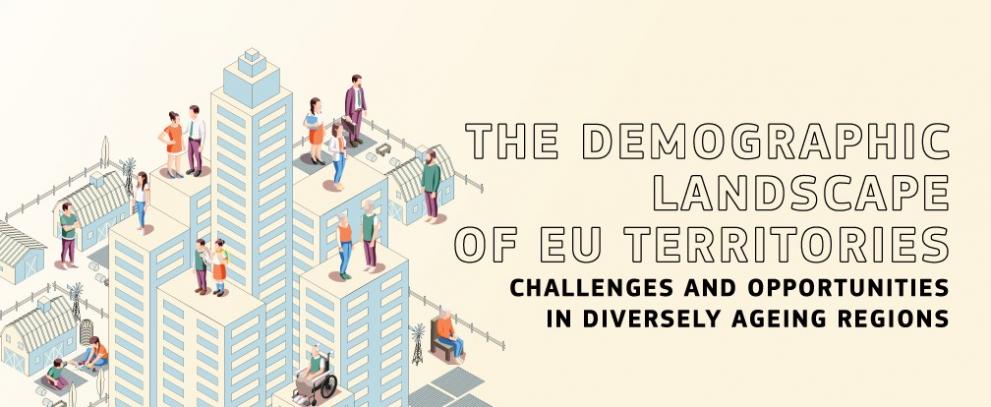
Europe’s population is getting older, but not all places are ageing equally.
And the gap between regions of population growth and regions of population decline is set to get wider in the coming decades, according to a new report on demographic change from the Commission’s Joint Research Centre.
'The Demographic Landscape of EU Territories' moves beyond traditional country-level analysis to explore demographics at different scales: from regions, right down to individual neighbourhoods.
The report assesses the impact of Europe’s diverse ageing and population trends on labour productivity, GDP, access to services, political attitudes and electoral outcomes over the last ten years. It also projects how these trends are likely to develop up to 2050. In doing so, the report provides new insights that can help target efforts to tackle economic inequalities and demographic imbalances.
European Commission Vice-President for Democracy and Demography, Dubravka Šuica, said: “This report on the Demographic Landscape of EU Territories provides the insights and tools necessary for us to better understand demographic change in Europe and to tailor our policies to the new realities on the ground. It helps us to capture the diversity of regional dynamics, which we will use to better target our initiatives in response to the new challenges we are all facing.”
Commissioner for Innovation, Research, Culture, Education and Youth, responsible for the Joint Research Centre, Mariya Gabriel, said: “This report draws on demographic expertise at the Commission’s Joint Research Centre, and is a welcome contribution to fostering effective policies to counteract economic or demographic decline. Demography is not only relevant for a strong European economy, but also for the functioning of our democracies.”
Main findings
- Youth mobility (particularly 20-24 year olds) has a major impact on demographic change, largely driven by study and work. Some regions are thriving thanks to the inflow of younger people, while others are lagging behind, with an increasing number of young people forced to leave due to lack of opportunities;
- Ageing and depopulation do not occur only in rural or remote areas but also in areas most at risk of depopulation, either urban or rural. Small and middle-sized urban areas may be depopulating because they lack the socio-economic attractiveness of global cities. The share of elderly is set to increase in all areas, but rural areas have the highest share;
- Residential preferences vary over the course of life, leading to migration that is also shaping demographic trends. The analysis suggests that young people generally move to urban areas for work or studies, families tend to prioritise affordable living spaces on the peripheries of urban areas, and that the elderly prefer to live in rural areas;
- Access to services varies for different ages: urban areas generally provide better access to services like shops and medical facilities than rural areas. Areas with less availability of services and amenities are less likely to attract younger people, which reinforces the negative circle of depopulation;
- Age divides are more pronounced than urban-rural divides on political beliefs, but there are clear political divides depending on both age and place of residence when it comes to views on the EU and immigration;
- Widening differences in ageing and depopulation between territories may worsen economic inequalities. The average change in the share of elderly could be 4 percentage points higher in areas experiencing population decrease than in areas where population is increasing. This may also result in polarisations in attitudes towards the EU and immigration, and the rise of populism;
These findings show that territorial demographic differences are not predetermined outcomes of the overall national trends for ageing, but are ultimately shaped by residential preferences and internal migration.
Regional and local cohesion and innovation policies can help address territorial imbalances by providing services and economic opportunities so that currently depopulated areas become more attractive places to live.
Background
While policy actions can only partially affect demographic trends, they can help ensure that the effects of the EU’s long-term demographic changes do not have negative repercussions on the economy or on productivity, social cohesion and democratic life.
In June 2020, the European Commission kick-started its work in this area with the Report on the Impact of Demographic Change. It presents the drivers of demographic change and the impact it is having across Europe. This latest report from the Joint Research Centre adds valuable insights on the territorial dimension and the challenges and opportunities presented and feeds into the work on the Long Term Vision for rural areas that the Commission will present in June.
The Commission has also recently adopted a Green Paper on Ageing, launching a debate that will help to identify the support needed for people, their regions and communities. A public consultation to discuss possible ways to anticipate and respond to the socioeconomic impacts of Europe’s ageing population is now open, and will run for 12 weeks.
The territorial population projections in ‘The Demographic Landscape of EU Territories’ are based on regional population projections derived by Eurostat from the EUROPOP13 national population projections, prepared for the 2015 ageing report. The appendix of ‘The Demographic Landscape of EU Territories’ contains a full description of the methods and regression models used to downscale and project population by age.
In the coming months, the Joint Research Centre will also launch an ‘Atlas on Demography’, a new tool to explore the EU’s population dynamics at a high spatial resolution.
Related Content
JRC report: The Demographic Landscape of EU Territories: challenges and opportunities in diversely ageing regions
Details
- Publication date
- 11 February 2021
